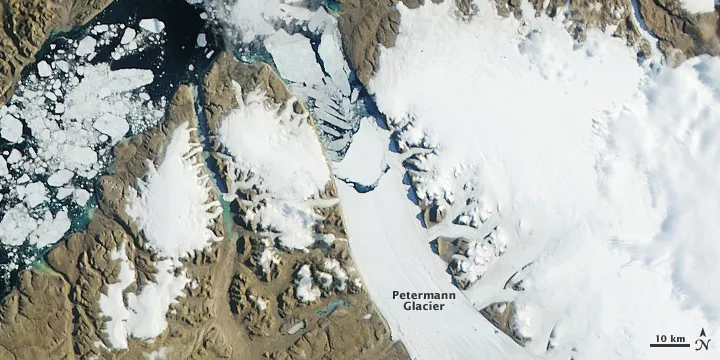Sea ice melt near Greenland can affect ice on the island in a couple ways. As sea ice retreats from the fronts of marine-terminating glaciers, the glaciers lose stability and may flow faster. In addition, earlier onset of sea ice melt near Greenland shows a modest correlation with earlier onset of ice sheet melt, and potential loss of ice from the entire ice sheet.
Sea ice loss and glacier calving
In August 2010, Greenland’s Petermann Glacier calved an iceberg. The iceberg that broke off from the Petermann was roughly 97 square miles (251 square kilometers). In July 2012, the glacier calved another ice island.
On a stable glacier, iceberg calving is a natural process that may release a large iceberg every few decades. When glacier calving accelerates, the glacier’s flow speed may also accelerate because the backpressure of the glacier front, buoyed by ocean water, has decreased.
Jason Box, professor in glaciology at the Geological Survey of Denmark and Greenland, has closely studied the Petermann Glacier, as well as the climate and ice of Greenland as a whole. He said, “Petermann is not the only loser in Greenland. In fact, there is a very clear pattern of glacier area loss all around the island.” Still, climatologists cannot blame the Petermann glacier event—or any specific ice breakup—squarely on climate change. There are too many variables that determine exactly when a glacier calves. Box said, “A single cracking event could conceivably be triggered by a seagull, acting like the straw that broke the camel’s back.” Data compiled by Box show that air temperatures in Greenland have risen sharply since the mid-1980s. The extent of melting and ice retreat has accordingly increased.
Sea ice loss and mass balance
Studies show that the ice on land and ice on the ocean surface are intimately related. The decline in sea ice surrounding Greenland could speed up ice loss from the Greenland Ice Sheet. The Greenland Ice Sheet covers roughly 1.7 million square kilometers (650,000 square miles). This ice sheet is so massive that, if it melted away completely, global sea level could rise roughly 7 meters (23 feet).
To assess an ice sheet’s contribution to sea level, scientists track its mass balance. Mass balance is the difference between the ice sheet’s total growth from snow, and its total loss from melt, evaporation, and/or calving. So long as an ice sheet gains as much as it loses, glaciologists consider the ice sheet to be in balance. If an ice sheet is losing more than it is gaining—including losing ice from calving—global sea level could be on the rise.
Box said, “It is reasonable to speculate that changes in sea ice duration and concentration in the vicinity of glacier fronts should impact their stability. As the sea ice melts, the ocean can be stirred up more by strong Arctic winds and change fjord water circulation and the sub-marine melt regime.” Winter sea ice also acts as a buttress against glacier ice flow, seasonally slowing the flow speed. An earlier break-up and later freeze-up of sea ice in the fjords may play a role in the ice sheets’ mass balance.
Early melt catches on
Sea ice reflects most of the sunlight that reaches its surface. Ice-free ocean water absorbs nearly all of the sunlight that reaches its surface. Seawater’s energy absorption may affect more than ocean temperature.
A study published in 2017 found that when sea ice in Baffin Bay, just west of Greenland, starts melting unusually early in the spring, that melt correlates with early onset of melt on the ice sheet. The study’s authors suggested that sea ice retreat in Baffin Bay increases the transfer of heat from the ocean to the atmosphere over the Greenland Ice Sheet, increasing surface melt. The correlation between sea ice melt and ice sheet melt was modest, and the authors pointed out that other factors were also at work, such as regional air temperatures.
Impact on sea level
Sea ice melt does not contribute to sea level rise, just as ice melting in a cold drink will not raise the liquid level in the glass. But the miles of ice that cover Greenland are different: if that ice melts, it would be like adding more ice cubes to that glass. Measurements show that Greenland’s ice does indeed flow into the ocean faster than snow accumulates on the island. This means that sea level is rising—a potential problem for people around the world. “As ice sheets continue to contribute to sea level rise, as expected in climate warming scenarios, the effects will be felt not just in coastal areas," Box said, “The effects will also be felt globally, where the coastal impacts lead to economic ripple effects.”
References
Box, J.E. and D.T. Decker, 2011. Analysis of Greenland marine-terminating glacier area changes: 2000-2010. Annals of Glaciology 52(59) 91-98.
Box, J.E., et al. 2009. Greenland ice sheet surface air temperature variability: 1840-2007. Journal of Climate 22(14): 4,029-4,049, doi:10.1175/2009jcli2816.1.
Howat, I.M., and A. Eddy. 2011. Multi-decadal retreat of Greenland’s marine-terminating glaciers. Journal of Glaciology 57(203): 389-396.
Johannessen, O.M., et al. 2011. Petermann Glacier, North Greenland: massive calving in 2010 and the past half century. The Cryosphere Discussions 5: 169-181, doi:10.5194/tcd-5-169-2011.
Moon, T. et al. 2019. The expanding footprint of rapid Arctic change. Earth's Future 7: 212-218. doi:10.1029/2018EF001088.
Rückamp, M. 2018. Calving induced speedup of Petermann Glacier. Journal of Geophysical Research: Earth Surface 124: 216-228, doi:10.1029/2018JF004775.
Stroeve, J. et al. 2017. Investigating the local-scale influence of sea ice on Greenland surface melt. The Cryosphere 11: 2363-2381, doi:10.5194/tc-11-2363-2017.
